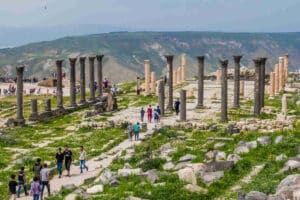If you are a traveler keen on history and archaeology, exploring the statues of Ain Ghazal in Jordan can be a compelling proposition. In this post, we share what they are, where they are, and most importantly, the reasons that will persuade you to include them in your travel itinerary.
What are and where are the statues of Ain Ghazal?
The statues of Ain Ghazal are a series of anthropomorphic and zoomorphic figures that were discovered decades ago at the site bearing the same name, on the northern outskirts of the capital, Amman, during the construction works of the Zarqa highway.
They date back to the 8th millennium B.C. and are part of the collection of the Jordan Museum, which we mentioned in this post. Moreover, there are some specimens scattered across other museums globally, especially the British Museum in London and the Louvre Museum in Paris. Thus, one should not confuse these statues with the archaeological site itself, which is not set up for tourist visits, nor with the statues from other museums.
Reasons to behold the statues of Ain Ghazal
As mentioned, if you are passionate about history and archaeology, you won’t need reasons to admire the statues of Ain Ghazal. But if you are unsure whether to visit the Jordan Museum or not, here are some motives that will convince you to do so.
#1. Local Identity Marker
Though Jordan and Amman have many other symbols attracting tourists, these statues have become a local identity marker due to their uniqueness. So, if you love to see and understand truly authentic elements, you shouldn’t miss visiting these unique figures.
#2. Remarkable Antiquity
One feature that makes the statues of Ain Ghazal stand out is their remarkable age: dating back to the 8th millennium B.C., during the Pre-Pottery Neolithic, they are considered among the earliest representations of the human figure in sculptural form.
#3. Striking Materials
Accustomed to gazing upon ancient statues made of stone or even metal, it’s remarkable that these statues have survived so long despite being crafted from such humble materials: limestone plaster over a core of reed twigs. For the eyes, which are outlined, bitumen was used. However, any wigs or headdresses that might have adorned their heads have not been preserved.
#4. Distinctive Aesthetics
Simply observing the Ain Ghazal statues for a few seconds reveals their distinctive aesthetic, mainly due to the hypnotic profile of the eyes and the disproportionate bodies with a truncated torso and absence of upper limbs. Additionally, some specimens are two-headed, with dual faces atop the simple bust.
#5. An Aura of Mystery
There’s no consensus on the intended purpose of these Ain Ghazal statues. As a result, they’re surrounded by an aura of mystery, especially considering that some exhibit signs of stabbing in their vital areas. Hence, while some experts believe they might have had a votive purpose, honoring ancestors, others argue the opposite: these were figures upon which some form of punitive ritual was enacted.
In conclusion: The Ain Ghazal statues are invaluable artifacts, both for their age and uniqueness. So, if you’re interested in discovering them, do let us know when designing your travel itinerary: we will advise you on the best way to visit the Jordan Museum, where they are displayed.
Imagen: Jeanhousen. Wikimedia Commons



